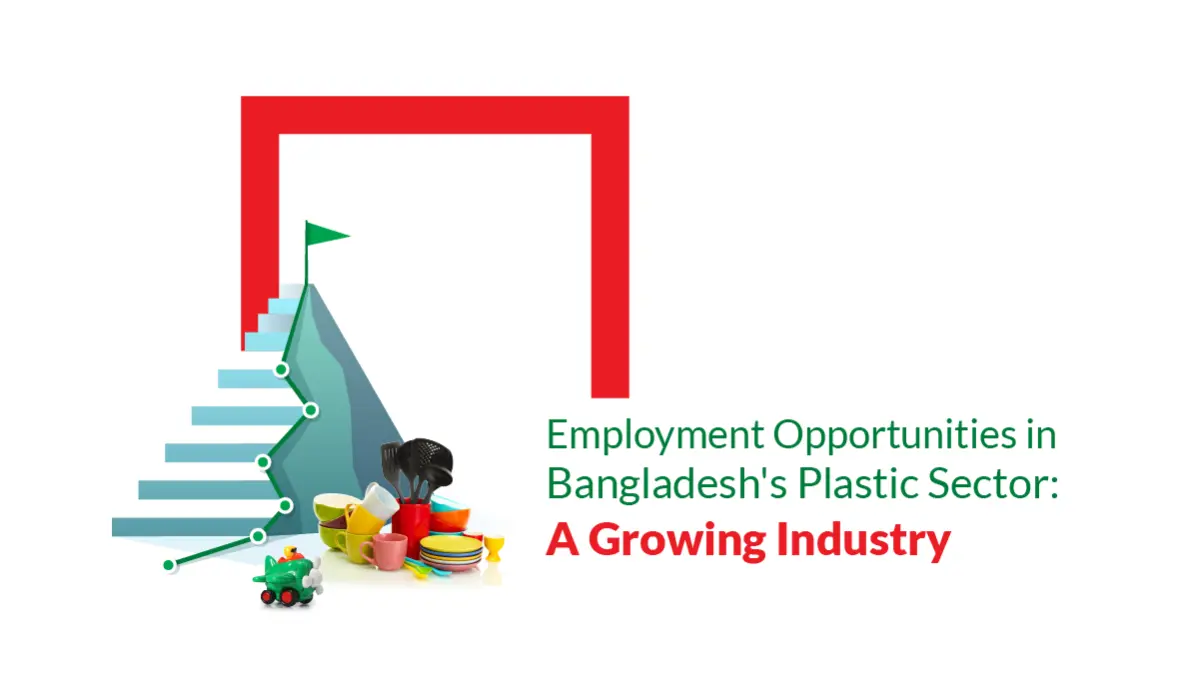The plastic industry of Bangladesh is now a massive contributor to job creation in the country, providing employment for people with diverse skill sets. With a current market size of $2.99 billion, the sector has been witnessing impressive growth of 20% per annum over the last few years, positioning it as one of the most vibrant industries in the country. This phenomenal progress has made this sector a vital job provider, accommodating employees ranging from skilled to unskilled in versatile roles. The presence of the plastic industry is dotted throughout the country, with an estimated 5,030 plastic enterprises situated in varying districts. Dhaka, Chittagong and Narayanganj are major manufacturing hubs, and Khulna, Comilla, Bogura, and Rajshahi are rising clusters. The geographical spread of MNC investments in the country also helped create employment avenues in various parts of the country and contributed greatly to the economic development in these regions as well. The plastics sector now stands as the 12th highest-earning export sector in Bangladesh, according to export performance. Since 2014, the industry has been growing steadily, at an average pace of 4.5% a year. During 2021-22, the export earnings jumped by 44.21% to USD 166.58 million in this sector. This export success generated more jobs, especially in export-oriented manufacturing units. Such export accomplishment has resulted in more job openings, especially in manufacturing units that are export-oriented. A wide array of employment opportunities emerges within the plastic sector. Today, the industry directly employs more than half a million workers across many different job categories, including technical positions in manufacturing and professional positions in management and marketing.
Current Market Overview
The plastic industry in Bangladesh has witnessed significant growth in the last decade. According to the Bangladesh Plastic Goods Manufacturers and Exporters Association (BPGMEA), the sector presently:
- Represents about 1.0% of the national GDP
- Over 5,000 primary manufacturing units (86% Small, 11% medium, 3% large)
- Directly employs approximately 1.5 million people
- Annual turnover of about BDT 350 billion (USD 3.5 billion)
Market Growth Trajectory.
Since 2011, the plastic sector has sustained an average annual growth rate of 20%, far exceeding overall GDP growth. In line with this growth, 2023-24 saw plastic products attain export earnings of USD 245 million, which was nearly 20% more than the previous year, despite challenges in the international economy.
Distribution of employment in the plastic sector
The industry has been especially prolific in building prospects for not only highly skilled technicians but also for entry-level workers with varying levels of experience and potential job progression.
The workers in the plastics sector can be broadly categorized as production-related workers and other sales and managerial-related workers, irrespective of the size of the firm. Some career paths related to production are production manager, supervisor or senior operator, assistant operator or semi-operator and helper. Managerial and administrative-related workers include broadly clerical and sales, accounts and finance- related employees. The owner of the industry is responsible for monitoring and administering both production and administrative-related employees. Usually, production work is taken from one producer to one master technician/operator to several technicians/semi-operators and several helpers. The title of each occupation and the number of workers in each occupation are firm-specific according to the size of the firm (large, medium or small).
Key Growth Drivers and Employment Potential
Massive employment opportunities are created in the plastic sector of Bangladesh due to several factors, as mentioned below:
- Diversification of Product Export: Government support policies have encouraged industry leaders to reduce their reliance on RMG and to view the plastic sector as a strategic industry.
- Growth in the domestic market: Growing middle-class consumption drives increased demand for plastic products in all household goods, flexible packaging, and construction materials.
- Backward Linkage Development: By 2027, the first petrochemical complex in Bangladesh is expected to generate 25,000 direct jobs and 100,000 indirect job opportunities.
- Recycling Initiatives: A 2022 UNDP report on sustainable plastic management estimates that the up-and-coming plastic recycling subsector will create 50,000+ green jobs by 2030.
Skills Gap and Training Needs
While there is potential for growth, the sector has significant skills challenges:
- One of the reasons for this is that just 23% of the workforce has ever received formal technical training
- 67% of businesses face problems in hiring qualified technical staff
- To bridge skills gaps, 85% of enterprises train internally
To fill this gap, the Bangladesh Industrial Technical Assistance Centre (BITAC) and private sector initiatives are offering specialized training programs in:
- Modern machinery operation
- Mold design and maintenance
- Quality management systems
- Circular Economy Practices for Plastic Manufacturing
Linkage with other industries
The global plastic market is expected to hit $721 billion in 2025, according to BPGMEA. If Bangladesh manages to capture 1% of the market, products amounting to over Tk 6,000 crore can be exported annually. However, the annual growth rate is likely to hit 25% soon. The plastic industry is not only a sector of its own but has also supported several industries as its backward industry. Life-saving drugs in injection packets, blood collection bags, hangers and packets in the readymade garments sector, crockery products, doors, windows, sanitary products, electrical appliances, computer parts, telephone sets, and a variety of toys are some of the plastic products manufactured in the country.
List of Sectors Supported by the Plastic Industry in Bangladesh:
| 1. Retail Packaging | 2. Agricultural Product |
| 3. Industrial and Bulk Packaging | 4. Poultry & Fishing |
| 5. Pharmaceuticals Products | 6. Automobile and Cycle |
| 7. Household Products | 8. Electronics |
| 9. Office Equipment | 10. Textile Articles |
| 11. Building Materials | 12. Musical Products |
| 13. Engineering Parts and Industrial Parts | 14. RMG Accessories |
| 15. Medical Equipment 16. Plastic Toy | 16. Plastic Toy |
The current status of the working labour force
Bangladesh has a huge scope for investment in the plastic sector. There is also a high demand for, but a low supply of, skilled labour force. Skilled labour has a higher turnover in the plastic sector compared to others. Hence, the cost of labour in the plastics sector is high. The average gross salary of plastic sector workers is BDT 8,000, and the workers start their careers as assistant operators in any firm in all situations. After a few years, the salary increases and can reach BDT 25,000 on average. Normally, the operators either ascend through the management ranks or start a new firm after a few years once they have learned the ropes. The skills gained from hands-on training are the only ones that the operators get; the sector is highly specialized in terms of the machines the operators have to operate. The top of the salary structure can go as high as BDT 45,000 for the second in command of his enterprise, who started his career as a helper, as an industry insider said about their enterprise.
VALUE CREATION FROM PLASTIC WASTE
800k tons of plastic waste is produced annually. In Bangladesh, the vast majority of single-use plastic is not recycled but instead ends up in landfills, the local environment or the ocean. Problems of single-use plastic management are on the rise. This is why, recently, Faridpur, Satkhira, and two other districts took under a project helping approximately 50,000 people get job opportunities. A rapid city assessment conducted recently revealed that around 6.2 tonnes of single-use plastic waste is being generated every day in the city of Faridpur.
Future Employment Outlook
According to research by the Bangladesh Institute of Development Studies (BIDS), the plastic sector has the potential to create at least an additional 400,000 direct jobs by 2030 if challenges are addressed. Employment is projected to grow much faster than average in:
- Data with limited or specialized usage: Medical devices, automotive parts, technical components
- Recycling and sustainability: Circular economy and green design
- Export-oriented units: Especially into packaging and household items
Employment generation scope through this sector
Nurturing more companies in the plastic industry has immense scope for employment generation. There seems to be a widely held belief among insiders that the entrepreneurs, or potential entrepreneurs, do not possess relevant technical skills, including knowledge of operations in their industry. The government agency or window that may have provided the specific knowledge might boost the growth of the sector many-fold and improve efficiency. Currently, entrepreneurs build up knowledge informally by visiting competitors in 16 countries or, moving forward, taking uninformed risks blindly. Moreover, there was a wide agreement on the absence of a skill set in designing, mould-making, R&D and so on.
Future Prospects
The resulting growth of the industry is further fueled by innovation in sustainable practices such as plastic waste disposal or recycling. Such approaches are being undertaken to recycle plastic waste and reclaim the raw materials from the plastic that can be used to provide more jobs in this green economy. Such initiatives are not only solving environmental issues but also generating new forms of employment in sustainable manufacturing and waste management. In the future, the sector hopes to claim 3% of the global market share by 2030 and is expected to generate a variety of job opportunities. A workforce skilled in mastering advanced manufacturing processes and meeting international quality standards will be required to sustain this expansion. Industry stakeholders are already investing in training programs and skill development initiatives to help workers transition into these new jobs. Nonetheless, the industry does have some challenges in workforce development. The per capita consumption of plastics in Bangladesh is 5 kg/year, which is much lower than in many developing countries. That implies there is significant potential to grow and hence deliver employment opportunities with an evolving consumption pattern and demand in the market. With technological advancement, domestic demand and export opportunities, the outlook for employment in Bangladesh's plastic sector looks bright. Specialized Skill Development Workers in Bangladesh's plastic manufacturing industry have traditionally been skilled in general production processes. Still, as the industry continues to evolve, there is a need for specialized skills development to keep pace with the demands of modern plastic manufacturing and the increasing competition in the global market.
For job seekers in this sector, there is a range of specializations available, including machine operation, quality control, product development, and management positions. It regularly recruits for entry-level and experienced positions and rewards fair salaries and advancement opportunities. Bangladesh's effects of a 1.0% contribution can be driven around the studies of the GDP described in the second, similar to the wage and, therefore, the 3 different sectors, which means that the plastic sector must potentially make an impact in the stretching on the GDP of the nation. This growth trajectory indicates generational hiring for employment in future years, which makes this sector an ideal sector for career advancement and professional growth.
References
- (BPGMEA)
- Export Promotion Bureau of Bangladesh
- Bangladesh Institute of Development Studies
- UNDP Bangladesh. (2022). Sustainable Plastic Management and Green Jobs Creation in Bangladesh
- International Labour Organization
- Labor Market Study under Skills for Employment Investment Program (SEIP)
- Practical Action in Bangladesh
- The Financial Express
- The Business Standard
- Aspire to Innovate (a2i) Programme

